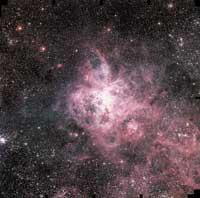The beauty of tarantula

Tarantula is the largest visible emission nebula in the sky. It is seen from the sky of the southern hemisphere and, despite the 1000 years of light, we see a little smaller than the full moon. Magellan is in the Great Cloud, a galaxy that revolves around the Milky Way to 170,000 light years from us. Because hydrogen and oxygen in the nebula have a violent and visible emission, the nebula is also visible to the naked eye.
It is also very appropriate for its study with telescope, and thanks to the ESO telescope located in Chile they have collected spectacular images. Red light is emitted by hydrogen atoms (652.2 nm) and greenish blue light is emitted from hydrogen atoms (486.2 nm) and oxygen ions (495.7 and 500.7 nm). Emission nebulae are nebulae that absorb ultraviolet radiation from surrounding stars and emit visible light radiation due to the ionization of the hydrogen it causes.





